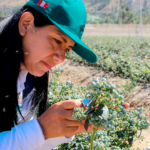Exporting Countries to the U.S. Market
Mexico is the major exporter to the North American country thanks to its proximity. Nearly all fruit enters through the state of Texas.
For avocados, most come from Mexico, though other key players include Colombia, Peru, Chile, Guatemala, Costa Rica, and Ecuador.
He added that Ecuadorian banana exports have seen a significant growth of 26%
“For example, red and yellow pitahaya have seen growth of over 61% compared to what it was in 2020. Mango has actually decreased by 10%, while pineapple has seen a percentage increase of 68%,” he noted.
Regulations
Regulations in the United States were also a talking point. He explained, "It’s not a difficult market to enter, but it is highly competitive. The traditional requirements include a commercial invoice, and all food products must be registered with the FDA."
Fresh products need to have a phytosanitary certificate validated by the agricultural institution of each country. "The document certifies that the product is free from pests and viruses," he said.
He added that FDA registration is required for traceability to identify the exporters, their plants' locations, processing facilities, and the products they handle.
Trends
Exporters and producers must pay attention to fruit consumption trends. There is currently a trend in the U.S. market for offering pre-cut fruits in trays or canned, since consumers are increasingly concerned about waste.
Additionally, he explained that traditional supermarkets, as well as independent stores, are seeing an increase in sales of exotic fruits.
It’s crucial to know where products are sold, as traditional fruits are mainly sold in larger retailers.
Recommendations
The second presentation was led by Manuel Echeverría, CEO of Trade & Business Partners, who clarified the need to segment based on the product, so in that way, people in the industry can define the area or region where we have the greatest opportunity.
He noted that California is a market that pays more for products, since “consumers are much more concerned about health and eating healthy, such as organic products, and they are willing to pay, for example, $1.25 for a banana.”
Echeverría pointed out that the fruits growing in demand in the United States are no longer mainly traditional ones, but rather those considered exotic, including pineapple, pitahaya, mango, lemon, "naranjilla," and ginger.
To succeed as an exporter in the North American market, “we have identified three key tools to acquire clients: international fairs, trade missions, and commercial representations.”
Experience
Finally, Denis Brito, president of Golden Sweet Spirit, shared his experience exporting exotic fruits to the United States.
He said that cape gooseberries are high in antioxidants and contain an impressive amount of carotenoids, which are hard to find in the everyday diet.
They are essential for vision and skin health, and support the immune system—“elements of great importance for the American consumer.”
He added that it is important to know the fruit's quality demand in international markets, stating that “this is one of the fundamental aspects of exporting.”
He concluded, "We need to create a value proposition and offer a product we ourselves would want to buy: good, beautiful, and affordable. The United States is increasingly interested in understanding the social impact of its value chain, what is being done, and how it is being managed.”















































